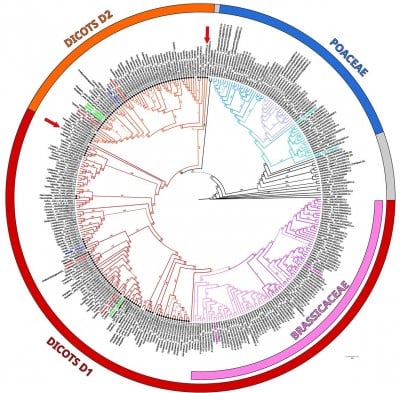Newswise — Phytochelatin synthases (PCSs) produce phytochelatins—tiny, cysteine-rich peptides that bind and neutralize toxic metal ions such as cadmium and arsenic. These molecules act as the plant’s natural detox system, sequestering harmful elements into vacuoles to prevent cellular damage. Although previous studies explored individual PCS genes in model plants like Arabidopsis thaliana (AtPCS1, AtPCS2), the broader picture of how PCS genes diversified across plant evolution remained unclear. Without understanding this evolutionary history, it has been difficult to explain why plants vary so widely in metal tolerance. Based on these challenges, researchers sought to uncover how gene duplication and functional divergence shaped PCS evolution across plant genomes.
A research team from the Fondazione Edmund Mach and the University of Pisa has traced the evolutionary origin of plants’ metal detoxification machinery. Their findings (DOI: 10.1093/hr/uhae334), published on March 1, 2025, in Horticulture Research, reveal that a long-overlooked duplication of PCS genes occurred early in the evolution of flowering plants. By combining genome-wide phylogenetic reconstruction with laboratory and plant-level experiments, the researchers discovered how this duplication—splitting into D1 and D2 lineages—enabled plants to fine-tune their biochemical defense against heavy-metal stress.
The study analyzed more than 130 complete plant genomes to map the evolutionary journey of PCS genes. The researchers discovered an ancient duplication, dubbed the “D duplication,” that emerged during the early diversification of eudicots and has been preserved ever since. This event divided PCS genes into two families: D1 and D2.
To explore their functions, the team isolated MdPCS1/MdPCS2 from apple and MtPCS1/MtPCS2 from barrel medic and introduced them into Arabidopsis thaliana mutants lacking native PCS activity. Laboratory assays revealed that D2-type PCS enzymes were significantly more active than their D1 counterparts, showing enhanced ability to synthesize phytochelatins and bind cadmium and arsenic.
In living plants, D2 genes conferred stronger growth recovery and higher tolerance under metal stress, while D1 genes maintained general thiol balance and moderate detox capacity. Sequence analysis identified two key amino acid residues likely responsible for their functional divergence. The results suggest that both gene types were retained because their complementary roles ensured efficient detoxification—a remarkable example of evolutionary fine-tuning that continues to protect modern crops.
“Our findings reveal how evolution refined a vital survival mechanism,” said Dr. Claudio Varotto, the study’s corresponding author. “The two PCS gene copies have coexisted for over a hundred million years because they complement each other—D1 provides stability, while D2 delivers power. This dual system gives plants the flexibility to adapt to a range of metal challenges. It’s a perfect illustration of how ancient genetic innovation continues to shape plant resilience today.”
This discovery not only deepens our understanding of plant evolution but also opens new pathways for sustainable agriculture. By targeting PCS gene expression or transferring D2-type PCS activity into sensitive crops, breeders could create varieties that thrive in contaminated soils while reducing heavy-metal accumulation in edible parts. Such genetic insights could also enhance phytoremediation strategies, where plants are used to clean polluted environments. As the world faces escalating soil contamination, understanding how plants evolved to endure toxic metals offers both scientific inspiration and practical tools for a safer agricultural future.
###
References
DOI
Original Source URL
https://doi.org/10.1093/hr/uhae334
Funding information
This work has been funded partially by the Autonomous Province of Trento through core funding of the Ecogenomics group of Fondazione E. Mach and by China Scholarship Council, grant number 201806740064 (J.Y. fellowship).
About Horticulture Research
Horticulture Research is an open access journal of Nanjing Agricultural University and ranked number one in the Horticulture category of the Journal Citation Reports ™ from Clarivate, 2024. The journal is committed to publishing original research articles, reviews, perspectives, comments, correspondence articles and letters to the editor related to all major horticultural plants and disciplines, including biotechnology, breeding, cellular and molecular biology, evolution, genetics, inter-species interactions, physiology, and the origination and domestication of crops.

